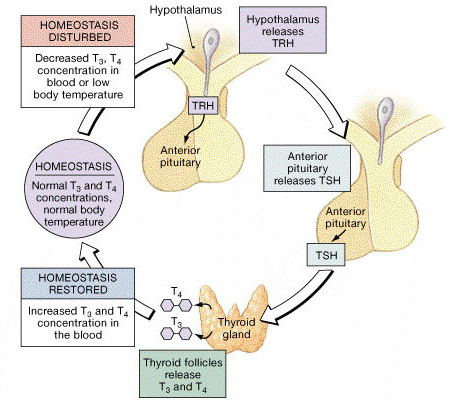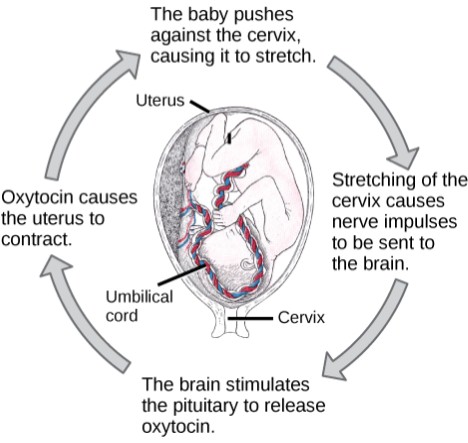
Feedback Mechanism-Negative feedback and Positive feedback
Feedback Mechanism: It is the general mechanism of nervous or hormonal control and regulation in Human.
Feedback system consists of a cycle of events in which information about a change is fed back into the system so that the regulator (brain) can control the process.
Negative feed-back mechanism
- The receptors (sensory cells) present on the body of vertebrates constantly monitors the reference point of internal environment. Any changes in the internal environment can activates the receptor cells, which relay messages to the control center (Brain or spinal cord). The control center determines the deviation and activates the effectors. Effectors are generally muscles or glands. The effectors respond to the stimulus and corrects the reference point either by increasing or decreasing the activities. As soon as the system is corrected, the control center and effectors are turned off by the mechanism called Negative feed-back.
- In negative feed-back mechanism, changes occurring in the system automatically activates the corrective mechanism, which reverse the changes and bring back the system to the normal. The principle of thermostat is analog to the Negative feed-back mechanism. In thermostat, when the temperature exceeds the normal ranges, the receptor detects the changes and signals the control center of thermostat to turn off the heating plate, allowing the thermostat to cool down. When the thermostat cool down below the set point, it turn ON the heating plates, so the temperature starts rise again.
The mechanism of Negative feed-back in biological system can be illustrated with the example given below.
Negative feed-back mechanism of thyroid gland
- Lower concentration of thyroxine hormone in blood alters the cellular activities ie. Decrease in basic metabolic rates or temperature. Decreases in BMR stimulates neurosecretory cells of hypothalamus to secrete thyrotropin releasing hormone (TRH). The releasing of TRH causes anterior pituitary gland to secrete thyroid stimulating hormone (TSH). This TSH then stimulates the thyroid gland to release thyroxine. Thyroxin causes an increase in the metabolic activity, generating ATP energy and heat and eventually restore homeostasis. Both the raised body temperature and higher thyroxine levels in the body feed-back to inhibit the releasing of TRH and TSH.

Figure: Regulation of Thyroxine hormone; an example of Negative feedback mechanism
- Most human system achieve homeostasis by Negative feed-back mechanism. Body temperature, blood glucose level, Blood PH, Blood pressure, Hormone level, Oxygen and Carbon-dioxide level, water and electrolyte balance etc are all controlled by negative feed-back.
Positive feed-back mechanism
- Positive feedback mechanism causes destabilizing effects in the body, so does not results in homeostasis. It is mainly responsible for amplification of the changes caused by the stimulus.
- Positive feedback is relatively less common than negative feedback, since it leads to unstable condition and extreme state. Most positive feedback mechanisms are harmful and in some cases resulting in death. For example, if a person breathes air that has very high carbon dioxide content. The amount of oxygen in blood decreases while the concentration of carbon-dioxide in blood increases. This is sensed by carbon dioxide receptors, which cause the breathing rate to increase. So the person breathes faster, taking in more carbon dioxide, which stimulates the receptors even more, so they breathe faster and faster which ultimately results in death.
- In some cases, the positive feed-back is very useful. Such as during blood clotting, fever, child birth, breast feeding etc. Positive feedback also plays a role in the contractions of the uterus during child birth. The contraction of uterine wall is caused by oxytocin hormone. In this case, stretching of the uterus by the fetus stimulates oxytocin release which results in contraction of uterus, and contraction causes further stretching and release of oxytocin; the cycle continues until the fetus is expelled from the uterus.

Figure: Regulation of oxytocin hormone; an example of positive feedback mechanism
